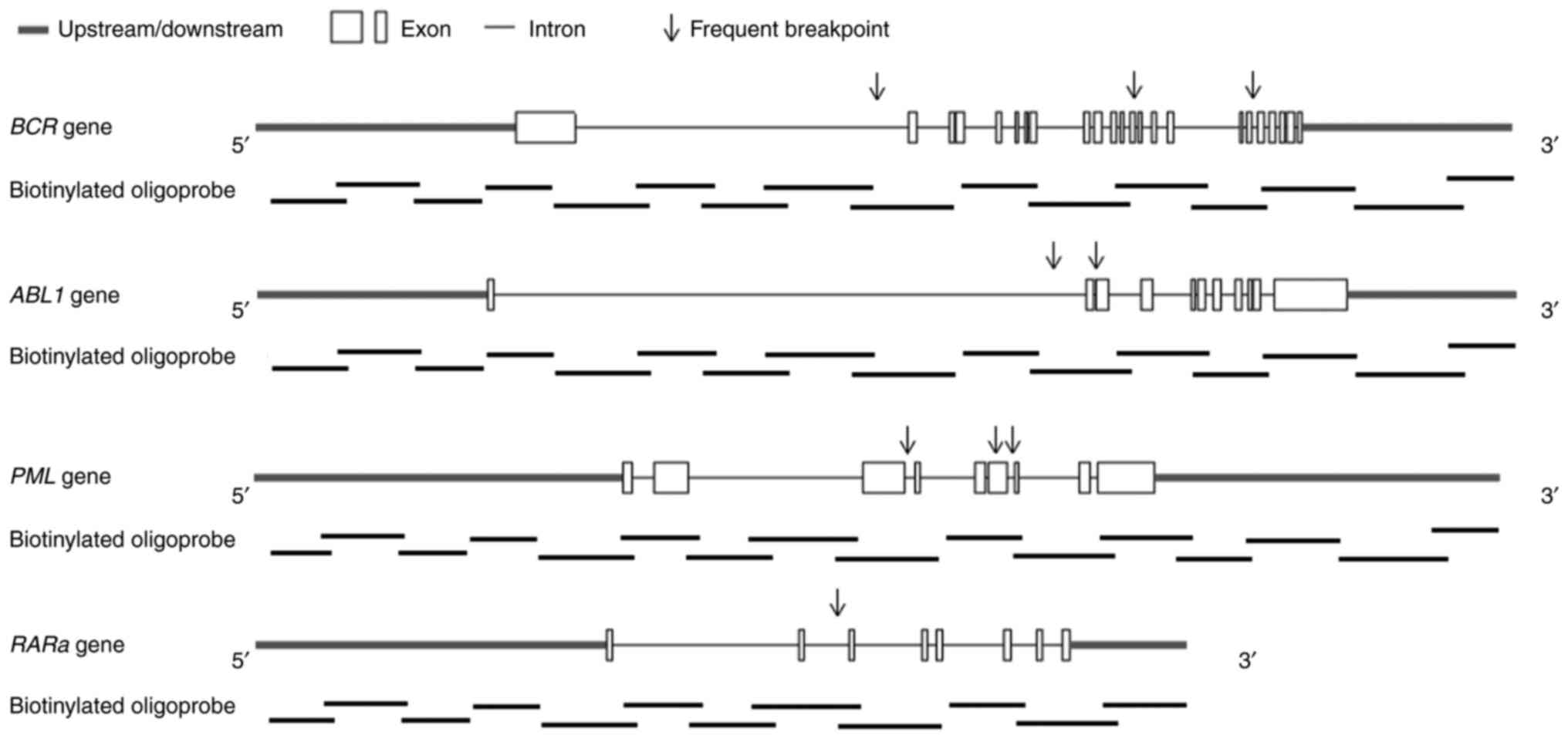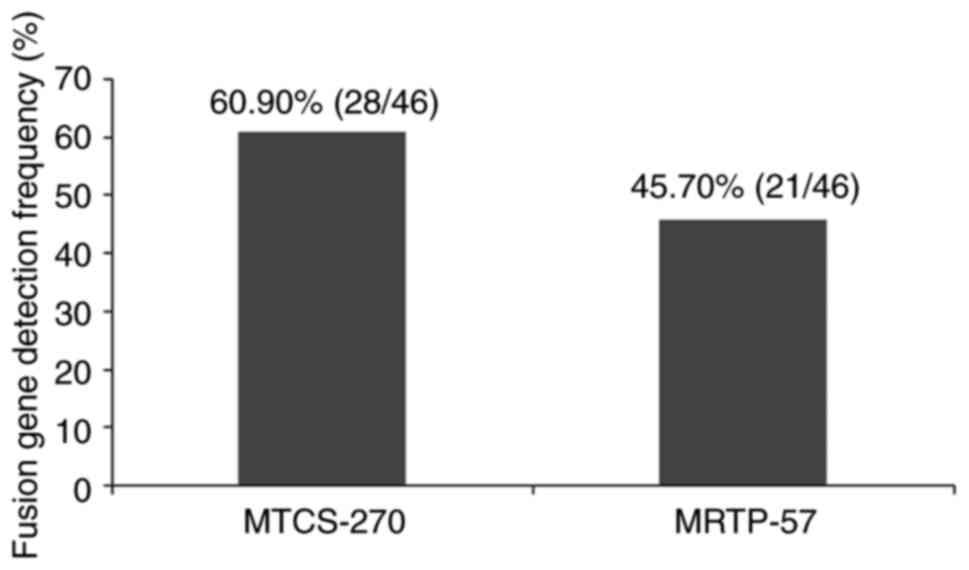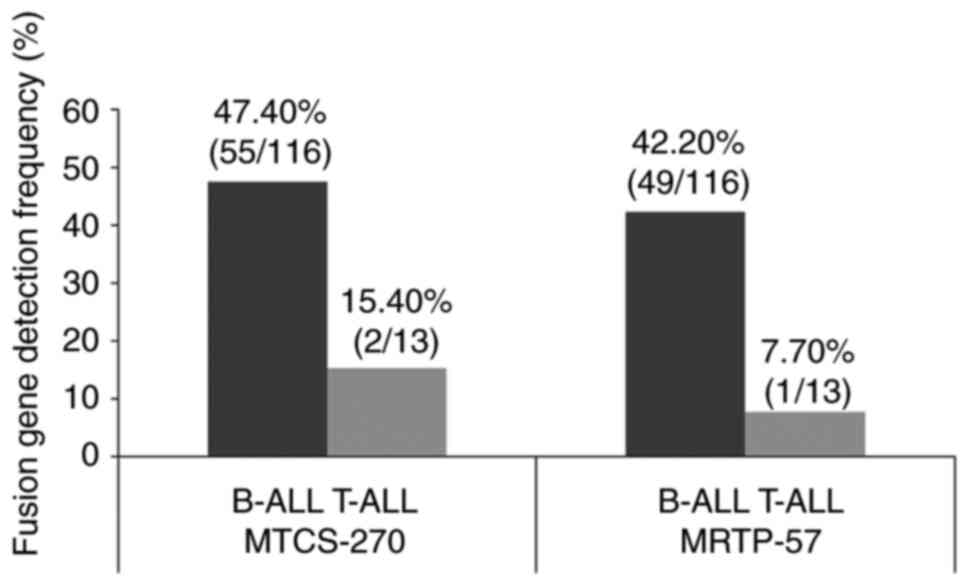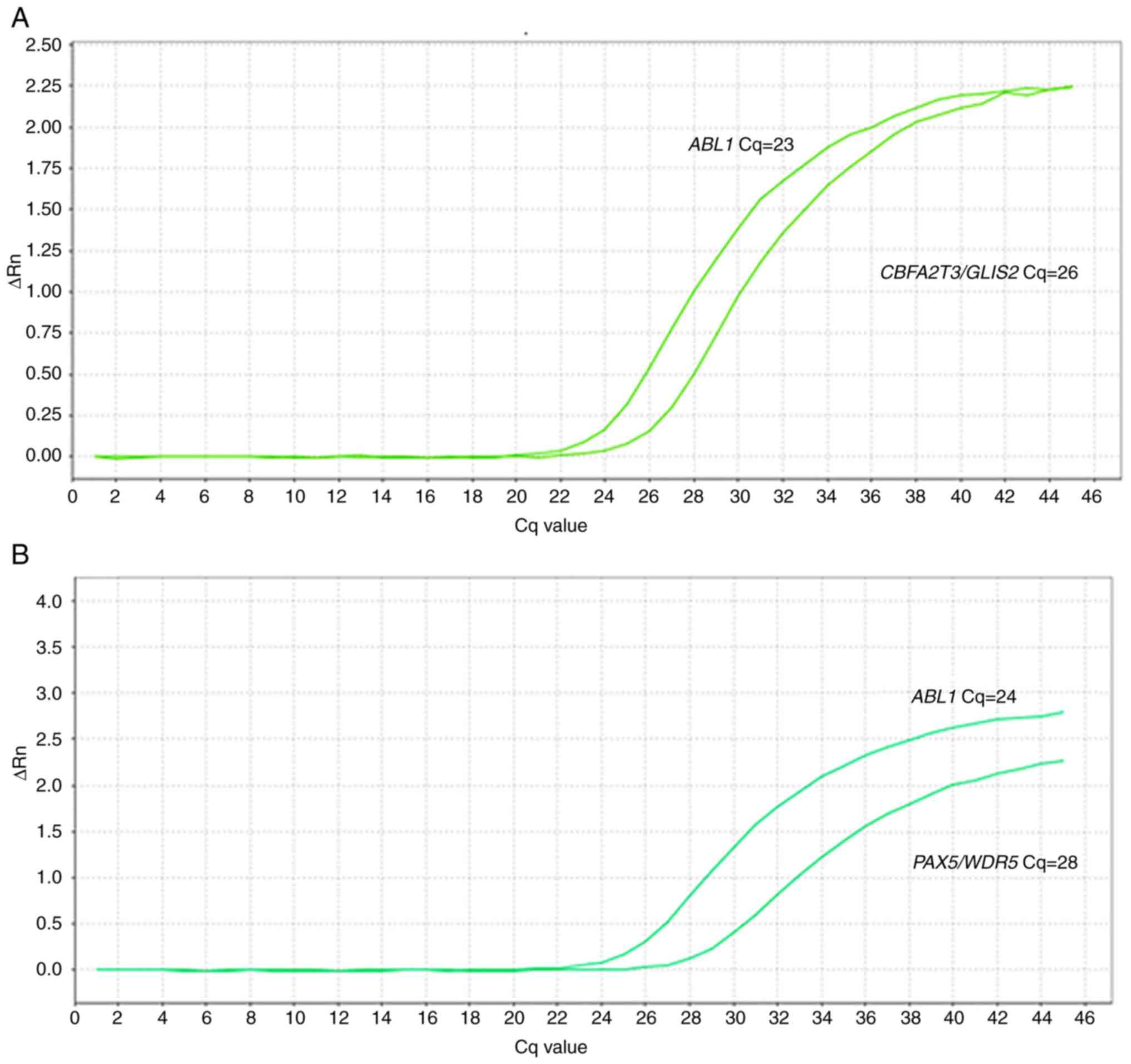|
1
|
Arber DA, Orazi A, Hasserjian R, Thiele J,
Borowitz MJ, Le Beau MM, Bloomfield CD, Cazzola M and Vardiman JW:
The 2016 revision to the World Health Organization classification
of myeloid neoplasms and acute leukemia. Blood. 127:2391–2405.
2016. View Article : Google Scholar : PubMed/NCBI
|
|
2
|
Wiemels J: Chromosomal translocations in
childhood leukemia: Natural history, mechanisms, and epidemiology.
J Natl Cancer Inst Monogr. 39:87–90. 2008. View Article : Google Scholar : PubMed/NCBI
|
|
3
|
Conneely SE and Rau RE: The genomics of
acute myeloid leukemia in children. Cancer Metastasis Rev.
39:189–209. 2020. View Article : Google Scholar : PubMed/NCBI
|
|
4
|
Taylor J, Xiao W and Abdel-Wahab O:
Diagnosis and classification of hematologic malignancies on the
basis of genetics. Blood. 130:410–423. 2017. View Article : Google Scholar : PubMed/NCBI
|
|
5
|
Xiong FF, Li BS, Zhang CX, Xiong H, Shen
SH and Zhang QH: A pipeline with multiplex reverse transcription
polymerase chain reaction and microarray for screening of
chromosomal translocations in leukemia. Biomed Res Int.
2013:1350862013. View Article : Google Scholar : PubMed/NCBI
|
|
6
|
Wang Q, Xia J, Jia P, Pao W and Zhao Z:
Application of next generation sequencing to human gene fusion
detection: Computational tools, features and perspectives. Brief
Bioinform. 14:506–519. 2013. View Article : Google Scholar : PubMed/NCBI
|
|
7
|
de Boer EN, Johansson LF, de Lange K,
Bosga-Brouwer AG, van den Berg E, Sikkema-Raddatz B and van Diemen
CC: Detection of fusion genes to determine minimal residual disease
in leukemia using next-generation sequencing. Clin Chem.
66:1084–1092. 2020. View Article : Google Scholar : PubMed/NCBI
|
|
8
|
Chen B, Jiang L, Zhong ML, Li JF, Li BS,
Peng LJ, Dai YT, Cui BW, Yan TQ, Zhang WN, et al: Identification of
fusion genes and characterization of transcriptome features in
T-cell acute lymphoblastic leukemia. Proc Natl Acad Sci USA.
115:373–378. 2018. View Article : Google Scholar : PubMed/NCBI
|
|
9
|
Jin Y, Wang X, Hu S, Tang J, Li B and Chai
Y: Determination of ETV6-RUNX1 genomic breakpoint by
next-generation sequencing. Cancer Med. 5:337–351. 2016. View Article : Google Scholar : PubMed/NCBI
|
|
10
|
Levy MA, Santos S, Kerkhof J, Stuart A,
Aref-Eshghi E, Guo F, Hedley B, Wong H, Rauh M, Feilotter H, et al:
Implementation of an NGS-based sequencing and gene fusion panel for
clinical screening of patients with suspected hematologic
malignancies. Eur J Haematol. 103:178–189. 2019. View Article : Google Scholar : PubMed/NCBI
|
|
11
|
Pallisgaard N, Hokland P, Riishøj DC,
Pedersen B and Jørgensen P: Multiplex reverse
transcription-polymerase chain reaction for simultaneous screening
of 29 translocations and chromosomal aberrations in acute leukemia.
Blood. 92:574–588. 1998. View Article : Google Scholar : PubMed/NCBI
|
|
12
|
Quessada J, Cuccuini W, Saultier P,
Loosveld M, Harrison CJ and Lafage-Pochitaloff M: Cytogenetics of
pediatric acute myeloid leukemia: A review of the current
knowledge. Genes (Basel). 12:9242021. View Article : Google Scholar : PubMed/NCBI
|
|
13
|
Iijima-Yamashita Y, Matsuo H, Yamada M,
Deguchi T, Kiyokawa N, Shimada A, Tawa A, Takahashi H, Tomizawa D,
Taga T, et al: Multiplex fusion gene testing in pediatric acute
myeloid leukemia. Pediatr Int. 60:47–51. 2018. View Article : Google Scholar : PubMed/NCBI
|
|
14
|
Ampatzidou M, Papadhimitriou SI, Paterakis
G, Pavlidis D, Tsitsikas Κ, Kostopoulos IV, Papadakis V,
Vassilopoulos G and Polychronopoulou S: ETV6/RUNX1-positive
childhood acute lymphoblastic leukemia (ALL): The spectrum of
clonal heterogeneity and its impact on prognosis. Cancer Genet.
224–225. 1–11. 2018.PubMed/NCBI
|
|
15
|
Moorman AV, Ensor HM, Richards SM, Chilton
L, Schwab C, Kinsey SE, Vora A, Mitchell CD and Harrison CJ:
Prognostic effect of chromosomal abnormalities in childhood B-cell
precursor acute lymphoblastic leukaemia: Results from the UK
medical research council ALL97/99 randomised trial. Lancet Oncol.
11:429–438. 2010. View Article : Google Scholar : PubMed/NCBI
|
|
16
|
Gu Z, Churchman M, Roberts K, Li Y, Liu Y,
Harvey RC, McCastlain K, Reshmi SC, Payne-Turner D, Iacobucci I, et
al: Genomic analyses identify recurrent MEF2D fusions in acute
lymphoblastic leukaemia. Nat Commun. 7:133312016. View Article : Google Scholar : PubMed/NCBI
|
|
17
|
Byron SA, Keuren-Jensen KV, Engelthaler
DM, Carpten JD and Craig DW: Translating RNA sequencing into
clinical diagnostics: Opportunities and challenges. Nat Rev Genet.
17:257–271. 2016. View Article : Google Scholar : PubMed/NCBI
|
|
18
|
Zhan D, Zhang Y, Xiao P, Zheng X, Ruan M,
Zhang J, Chen A, Zou Y, Chen Y, Huang G, et al: Whole exome
sequencing identifies novel mutations of epigenetic regulators in
chemorefractory pediatric acute myeloid leukemia. Leuk Res.
65:20–24. 2018. View Article : Google Scholar : PubMed/NCBI
|
|
19
|
Zhao J, Liang JW, Xue HL, Shen SH, Chen J,
Tang YJ, Yu LS, Liang HH, Gu LJ, Tang JY and Li BS: The genetics
and clinical characteristics of children morphologically diagnosed
as acute promyelocytic leukemia. Leukemia. 33:1387–1399. 2018.
View Article : Google Scholar : PubMed/NCBI
|
|
20
|
Ruiz-Argüelles GJ, Garcés-Eisele J,
Reyes-Núñez V, Gómez-Rangel JD and Ruiz-Delgado GJ: More on
geographic hematology: The breakpoint cluster regions of the
PML/RARalpha fusion gene in Mexican Mestizo patients with
promyelocytic leukemia are different from those in Caucasians. Leuk
Lymphoma. 45:1365–1368. 2004. View Article : Google Scholar : PubMed/NCBI
|
|
21
|
Livak KJ and Schmittgen TD: Analysis of
relative gene expression data using real-time quantitative PCR and
the 2(−Delta Delta C(T)) method. Methods. 25:402–408. 2001.
View Article : Google Scholar : PubMed/NCBI
|


















